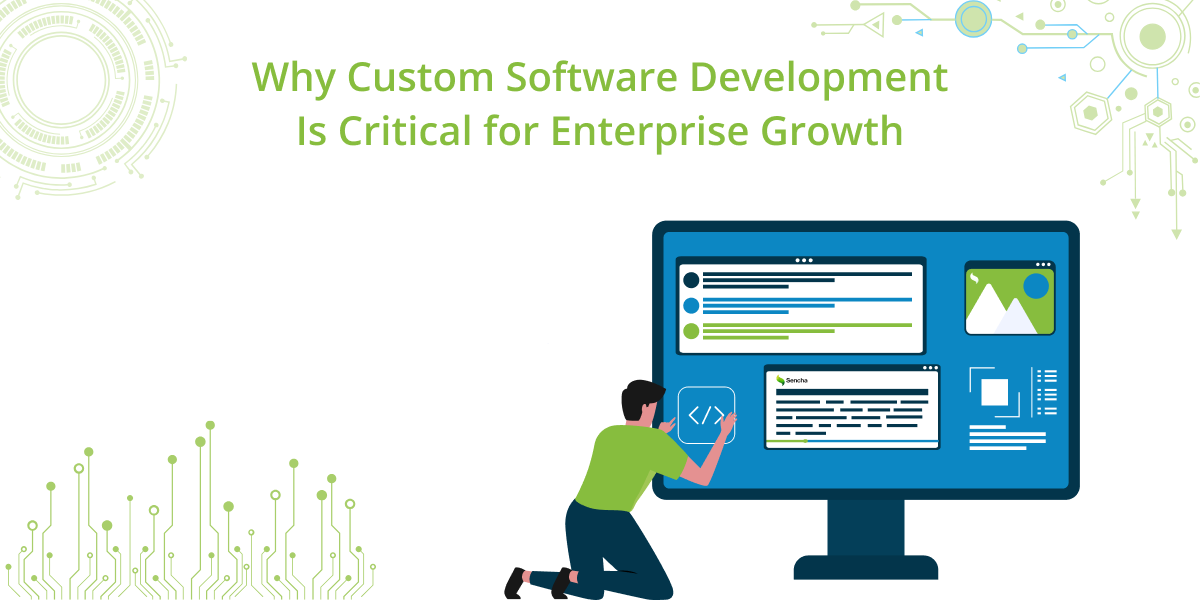Why Custom Software Development Is Critical for Enterprise Growth
The modern enterprise ecosystem thrives on agility, scalability, and digital innovation. In today’s competitive market landscape, pre-packaged solutions often fail to capture the intricate needs of large organizations with diverse workflows, compliance obligations, and legacy dependencies.

That’s where custom software development becomes a strategic enabler — providing the power to build precisely what the business needs, no more and no less.
Custom enterprise software enables organizations to harness scalable software architecture, intelligent automation, and data-driven intelligence to stay ahead. When combined with the right front-end framework, it transforms not only operations but also the customer experience.
Among the available technologies, Ext JS stands out as the most robust and enterprise-grade front-end JavaScript framework — designed to power complex, long-lived business applications with unmatched performance, reliability, and maintainability.
What Is Custom Software Development?
Custom Software development platforms refer to the process of designing, building, testing, and deploying applications uniquely tailored to an organization’s needs. Unlike off-the-shelf software, which is built for broad use cases, custom solutions are aligned directly with a company’s workflows, data models, and strategic goals.
Core Benefits:
- Business-Specific Functionality: Built around tailored processes for departments such as finance, operations, or HR.
- Scalable and Secure Architecture: Designed for long-term performance under high data loads.
- Seamless Integration: Connects efficiently with legacy systems, APIs, and third-party tools.
- Enhanced ROI: Reduces long-term licensing costs and dependency on external vendors.
How Custom Software Fuels Enterprise Growth
Custom enterprise applications empower organizations to achieve digital transformation on their own terms. Let’s explore how.
1. Strategic Alignment with Business Goals
Custom development ensures that software evolves with the business. New modules, APIs, and microservices can be added without affecting core functionality, preserving business continuity and operational efficiency.
2. Unleashing Automation and Efficiency
Through business process automation, custom software eliminates repetitive manual tasks. Enterprises gain a measurable increase in workflow productivity, compliance accuracy, and decision-making speed.
3. Scalability and Adaptability
Custom architectures are inherently scalable — whether adding new features, onboarding users across regions, or integrating emerging technologies like AI or IoT.
4. Data Security and Compliance
Tailored software supports strict regulatory needs (GDPR, HIPAA, ISO 27001). Data encryption, adaptive access control, and robust API gateways ensure integrity and compliance.
5. Legacy System Modernization
Outdated systems often hinder enterprise agility. Through custom modernization, businesses can retain critical logic while migrating to cloud-native architectures and integrate via APIs — preserving long-term investments.
Why Your Enterprise Technology Stack Matters
Choosing the right technology stack underpins every digital transformation effort. The right combination of back-end and front-end frameworks determines how quickly you can deliver, evolve, and scale enterprise applications.
Key layers of a successful enterprise tech stack:
| Layer | Examples | Purpose |
|---|---|---|
| Front-End | Ext JS, React, Angular | User interfaces, performance, client-side logic |
| Back-End | Java, .NET, Node.js, Python | Business logic, APIs, integration |
| Database | PostgreSQL, MongoDB, Oracle | Data storage and integrity |
| Cloud Services | AWS, Azure, GCP | Deployment, resilience, scalability |
| DevOps | Jenkins, Docker, Kubernetes | Continuous integration & delivery |
Among these, the front-end framework often defines user experience (UX), application agility, and interface longevity — and that’s where Ext JS outperforms its competition.
Ext JS: The Gold Standard for Enterprise Front-End Development
Ext JS, developed by Sencha, is widely recognized as the leading enterprise JavaScript framework for building scalable, data-driven web applications.
Unlike most frameworks that prioritize simplicity over robustness, Ext JS is built for enterprise-grade demands — large teams, mission-critical applications, and coherent UI/UX consistency over years of use.
Technical Strengths of Ext JS
1. Rich Component Library
Ext JS offers over 140+ pre-built UI components, including advanced data grids, charts, forms, trees, pivot tables, and calendars. These aren’t simple widgets — they are fully enterprise-grade, data-intensive components capable of handling tens of thousands of records seamlessly.
2. Unmatched Data Handling & Performance
Built for scale, Ext JS provides a powerful data package with models, stores, and proxies that manage complex data flows efficiently.
Features like virtual scrolling, data pagination, and optimized rendering make it ideal for business intelligence dashboards, ERP systems, and CRM platforms.
3. Consistent Look & Feel Across the Enterprise
Enterprises often struggle with UI fragmentation across multiple internal tools. Ext JS solves this with consistent theming, layouts, and design systems, ensuring a uniform experience across all devices and departments.
4. Cross-Browser and Cross-Platform Compatibility
From Chrome to Edge, iOS to Android, Ext JS delivers responsive design and unified UX without breaking layouts or behaviors. Its responsive config system ensures performance across any viewport or device density.
5. Native Support for MVVM/MVC Architecture
Ext JS enforces clean architecture patterns like Model-View-ViewModel (MVVM) and Model-View-Controller (MVC) — ensuring large applications remain modular, testable, and maintainable.
6. Superior Tooling with Sencha Cmd
With Sencha Cmd, developers enjoy end-to-end lifecycle management — scaffolding, theming, code optimization, testing, and bundling, all optimized for performance. This reduces build times and minimizes deployment complexity.
7. Top-Tier Performance Optimizations
- Lazy rendering for viewport optimization
- Compact JavaScript builds
- Code minification and dead-code elimination
- Efficient DOM interaction
These features guarantee sub-second response times, even in data-heavy enterprise applications.
8. Strong Community and Enterprise Support
With extensive documentation, commercial support, and a long record of enterprise adoption, Ext JS provides predictability and long-term stability, ensuring that your tech investments remain future-proof.
Integrating Ext JS within Modern Enterprise Architectures
Backend Synergy
Ext JS integrates seamlessly with RESTful APIs, GraphQL endpoints, and microservices-based back-ends — whether powered by Java, .NET, Node.js, or Python.
With AJAX proxies, WebSocket connections, and API stores, it enables real-time data syncing with minimal overhead.
Cloud-Native Deployments
Ext JS applications can be deployed on AWS, Azure, or GCP, supporting containerization through Docker and Kubernetes.
Its modular structure aligns perfectly with DevOps pipelines and Continuous Integration/Continuous Deployment (CI/CD) workflows.
Enterprise Security Compliance
Integrations with SSO, OAuth, and JWT tokens make Ext JS a top choice for secure enterprise ecosystems — maintaining zero-trust compliance standards without sacrificing UX.
Ext JS vs Other Front-End Frameworks
| Feature | Ext JS | React | Angular | Vue.js |
|---|---|---|---|---|
| Component Library | 140+ prebuilt enterprise components | Relies on 3rd-party libs | Medium | Small |
| Data Handling | Built-in data package (stores, models) | External libraries | External | Limited |
| Architecture | MVC & MVVM | Unstructured | MVVM | Lightweight |
| Performance (Data-Intensive Apps) | High | Medium | Medium | Medium |
| Enterprise Support | Yes (Commercial) | Community-based | Good | Open-source only |
| Theming/UI Consistency | Native | Requires libraries | Partial | Manual |
| Long-Term Stability | 10+ years proven record | Varies | Stable | Moderate |
Measuring the ROI of Custom Software Development with Ext JS
- Reduced Development Time: Reusable components and frameworks accelerate delivery.
- Lower Maintenance Costs: Clean architecture cuts debugging and refactoring overhead.
- Enhanced UX & Productivity: Faster UI performance directly affects user efficiency.
- Future-Proof Technology: Consistent upgrades and compatibility ensure sustainability.
- Operational Excellence: Integration with analytics, automation, and reporting tools.
These factors compound into better Total Cost of Ownership (TCO) and ROI, making Ext JS a strategic technology investment, not just a framework choice.
Conclusion
Custom software isn’t just about building tools — it’s about engineering long-term growth infrastructure. With tailor-made systems, enterprises can scale operations, innovate faster, and stay compliant amidst evolving market demands.
And when it comes to building the front end of such mission-critical solutions, Ext JS remains unrivaled.
Its enterprise-grade features, performance optimization, security, and reliability make it the gold standard for building scalable, future-ready enterprise applications.
Choosing Ext JS isn’t choosing another JavaScript framework — it’s investing in a legacy of performance, power, and predictability.
FAQs
Why do enterprises prefer custom software over ready-made solutions?
Enterprises choose custom software because it offers scalability, flexibility, and competitive differentiation. It adapts as the business grows and aligns perfectly with existing systems and operations.
How does custom software development drive enterprise growth?
By automating processes, improving efficiency, enhancing customer experience, and enabling data-driven decision-making, custom software empowers enterprises to innovate and scale faster.
Is custom software more expensive than off-the-shelf tools?
While upfront costs can be higher, custom software delivers a better long-term ROI through reduced licensing fees, increased productivity, and lower maintenance costs over time.
What technologies are commonly used in enterprise-level custom software?
Enterprises often use Java, .NET, Python, React, Angular, Node.js, and cloud platforms like AWS or Azure to ensure high performance, security, and scalability.
How does custom software improve security and compliance?
Tailored systems allow businesses to implement custom security protocols and ensure compliance with industry standards such as GDPR, HIPAA, or SOC 2—reducing vulnerability risks.
Can custom software integrate with existing enterprise systems?
Yes. Modern APIs and microservice architectures make it easy to integrate custom software with CRMs, ERPs, and other business platforms, ensuring seamless data flow.
How long does it take to develop enterprise custom software?
Development time varies based on complexity, features, and integrations. Small applications may take 3–6 months, while large enterprise systems can take 6–18 months or longer.
What are the long-term benefits of investing in custom software?
Custom solutions offer better performance, full ownership, scalability, and adaptability—helping enterprises maintain a competitive edge and meet evolving market demands.

The integration of LLMs into web applications has largely focused on content generation and chatbots.…

ReExt is a React library developed by Sencha that allows you to use Ext JS…

Upgrading large-scale applications built with Ext JS often presents significant challenges for development teams. This…










